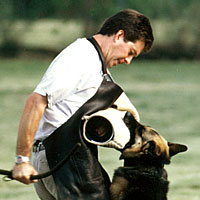
Jump. Over. Weave. Through. Stop! Stop today or for good? Agility enthusiasts are well aware of the rush you can get from seeing a dog run its fastest, jump its highest, and pit speed against the outer boundaries of control. While this adrenaline rush is a familiar high, some trainers have not experienced the dreaded transition to retirement. Equally intense, and at a polar opposite, retirement can be as sad as a dream run can be euphoric.
There is a special, indescribable bond that can be created along the journey of a dog’s career. The hours spent training, nourishing, and silently communicating brings a dog and handler as closely-knit as family. You and your dog share a beat, establish a rhythm and work as one. Teamwork. Purity. Joy.
Without you, a career for your dog would not be possible. Without your dog, the adrenaline rush of watching your work in progress would never be realized. Plainly, you need one another, and this can make the conclusion of an agility career such a struggle for so many people AND their dogs.
The matter comes down to understanding what is best for your canine partner and relinquishing that adrenaline rush you’ve become accustomed to, for the dog’s sake.
Easier said than done, right?
Like many of life’s hard choices, retiring your dog from agility is just that. A choice. It is not only a choice that everyone will have to make for him or herself, but also for their canine partner, whose only ability to speak on the matter is through an untranslatable bark, pant or nudge. The language created through hundreds, perhaps thousands, of hours of intangible communication.

Gerry Brown, an agility trainer with more than 19 years of experience, shares advice on what owners should remember when making this difficult decision.
“After 12 years of working with a dog, how do you stop?” Gerry found himself asking. As hard as it would be for him to make sense of retiring his dog, he knew that, “at some point, you just have to.”
When you start working with these dogs from pups to veterans in old age, “it is hugely emotional. Just sitting here talking about it almost brings tears to my eyes,” said Brown. He added that you have to be able to separate that emotion, because it is not about you anymore; it is about your dog.
Brown admitted that he wishes that he had quit six months ago with one of his current dogs. Knowing that Border Collies can run until they are about 13 years old, he had a different technique for one of his other Collies. For this agility champion, Brown set a goal, and the day she accomplished that goal was the day she no longer jumped championship heights.
Pam, another agility trainer, said that she would like to stop doing agility with her dog before it gets to the point where he is not doing agility for his own happiness, but for hers.
“I want to remember his joy and enthusiasm while running a course, not the little worried look he gets when something goes wrong, because he was hurting,” said Pam. “Mostly, I want him as strong and healthy as he can be, so his senior years are as joyful to him as his younger years were.”
Although this is an emotional transition, it is not the end for some dogs. Most dogs can still play agility doing simple activities, like tunnels or poles. Gerry’s collie was fully retired when she lost her last drop of competitive edge, but she still had a little time to play in the meantime. There was still a good amount of time to be spent between dog and trainer, just in a different way than they were accustomed to.
It’s also important to remember that not all dogs will run until the same age. Both breed specifically and individually, it’s key to understand how long your dog can keep a healthy pace. In some cases, it may be that estimated age, give or take a few years. So, how do we know when it is truly time to retire a dog?
When making your choice, it’s key to ask yourself: Is the dog still mentally and physically able to play this game and is there more risk of the dog being hurt today than a year ago?
Therein lies your individual answer. It’s a tough decision, but one in the best interest of your dog.
————————————————————————————————————————————
Doug holds degrees in Behavioral Sciences and Business Management and has been involved in all of Canine Training Systems Award Winning productions, earning over 35 broadcast awards for writing, shooting, editing and graphical design. When not working, he spends his personal time with his wife, three brilliant kids and team of working terriers. For more information, please visit his website at www.caninetrainingsystems.com
